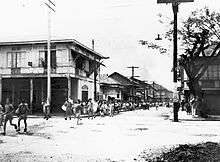Manila massacre
| Manila massacre (1945) | |
|---|---|
|
Photo of a Filipino woman and child killed by the Japanese forces in Manila. | |
| Location | Manila, Philippines |
| Date | 1945 (EDT) |
Attack type | mass murder, massacre |
| Deaths | est. 100,000+ |
| Perpetrators | |

The Manila massacre involved atrocities committed against Filipino civilians in the city of Manila, Philippines by Japanese troops during the World War II Battle of Manila (1945). The Manila massacre was one of several major war crimes committed by the Imperial Japanese Army, as judged by the postwar military tribunal. The Japanese commanding general, Tomoyuki Yamashita, and his chief of staff Akira Mutō, were held responsible for the massacre and other war crimes in a trial in late 1945 in Manila. Yamashita was executed on 23 February 1946 and Muto on 23 December 1948.
Description
Prior to the battle, deciding that he would be unable to defend Manila with the forces available to him, and to preserve as large a force as possible in the rural mountain Luzon region of the Philippines, General Tomoyuki Yamashita had insisted on a complete withdrawal of Japanese troops from Manila in January, 1945. However, Yamashita's order was ignored by approximately 10,000 Japanese marines under Rear Admiral Iwabuchi Sanji who chose to remain in Manila. Approximately 4000 Japanese army personnel were unable to leave the city due to the advance of the American and Filipino forces.
In the Battle of Manila from February to March 1945, the United States Army and the Philippine Commonwealth Army advanced into the city of Manila to drive out the Japanese. During lulls in the battle for control of the city, Japanese troops took out their anger and frustration on the civilians in the city. Violent mutilations, rapes, and massacres occurred in schools, hospitals and convents, including San Juan de Dios Hospital, Santa Rosa College, Santo Domingo Church, Manila Cathedral, Paco Church, St. Paul's Convent, and St. Vincent de Paul Church.[1]:113 Dr Antonio Gisbert told of the murder of his father and brother at the Palacio del Gobernador, saying, "I am one of those few survivors, not more than 50 in all out of more than 3000 men herded into Fort Santiago and, two days later, massacred.[1]:110 The Bayview Hotel was used as a designated "rape center".[2] According to testimony at the Yamashita war crimes trial, 400 women and girls were rounded up from Manila's wealthy Ermita district, and submitted to a selection board that picked out the 25 considered most beautiful. These women and girls, many of them 12 to 14 years old, were then taken to the hotel, where Japanese enlisted men and officers took turns raping them.[3]
One Japanese order read, "The Americans who have penetrated into Manila have about 1000 troops, and there are several thousand Filipino soldiers under the Commonwealth Army and the organized guerrillas. Even women and children have become guerrillas.
The combined death toll of civilians for the battle of Manila was approximately 100,000, most of which was attributed to massacres by Japanese forces. Some historians, citing a higher civilian casualty rate for the entire battle, suggest that 100,000 up to more than 500,000 died as a result of the Manila massacre on its own, exclusive of other causes.[1][4][5][6][7]
See also
Notes
- 1 2 3 Connaughton, R., Pimlott, J., and Anderson, D., 1995, The Battle for Manila, London: Bloomsbury Publishing, ISBN 0891415785
- ↑ "February 1945: The Rape of Manila | INQUIRER.net". Globalnation.inquirer.net. Retrieved 2016-11-17.
- ↑ Manila Girls Relate Horror of Mass Rape, The Milwaukee Journal, 1 November 1945
- ↑ White, Matthew. "Death Tolls for the Man-made Megadeaths of the 20th Century". Users.erols.com. Retrieved 2007-08-01.
- ↑ Khalifa, Hodieb. Nein. Books.google.com. Retrieved 2016-11-17.
- ↑ Dauria, Tom. Within a Presumption of Godlessness. Books.google.com. Retrieved 2016-11-17.
- ↑ "Battle of Manila". Battle of Manila. Retrieved 2016-11-17.
References
- Taylor, Lawrence. A Trial of Generals. Icarus Press, South Bend IN, 1981
- Quezon, Taylor (7 February 2007). "The Warsaw of Asia: How Manila Was Flattened in WWII". Arab News. Retrieved 25 January 2011.
External links
- WW2DB: The Philippines Campaign
- The Battling Bastards of Bataan
- The Historical Atlas of the Twentieth Century by Matthew White
Coordinates: 15°35′00″N 120°58′00″E / 15.5833°N 120.9667°E

